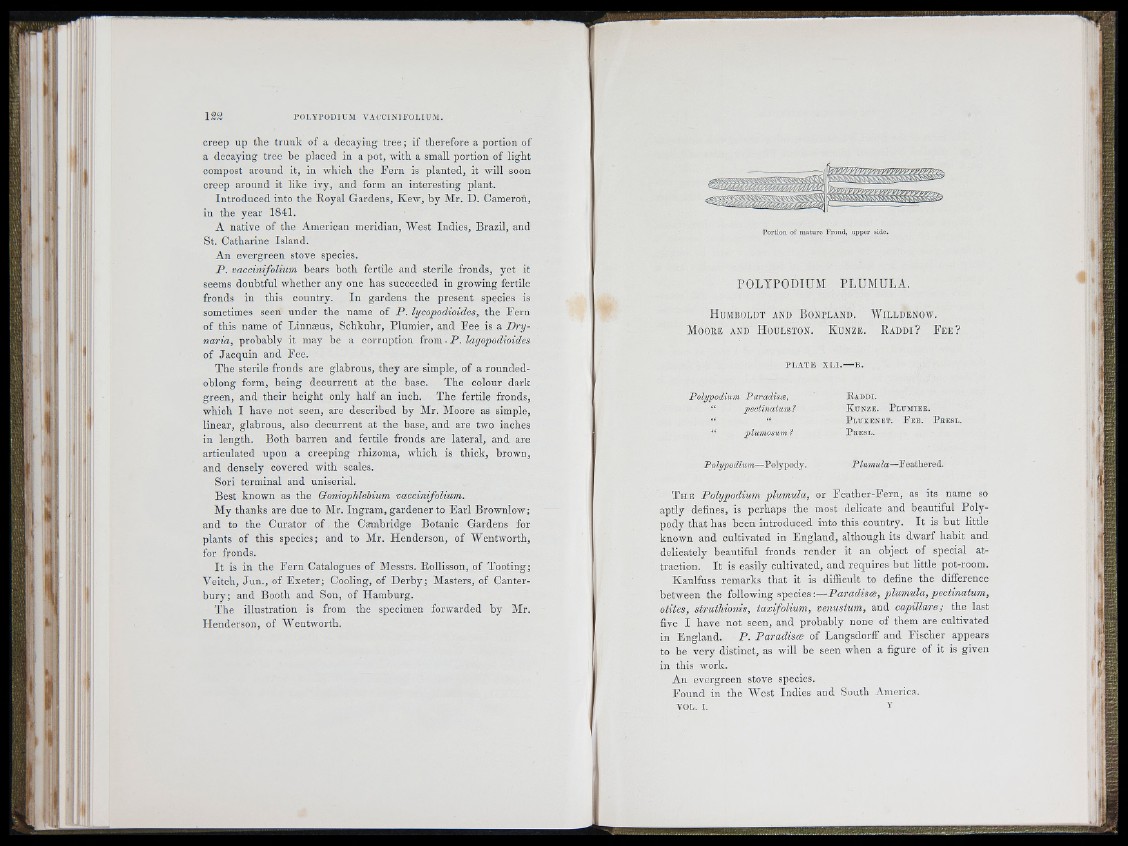
creep up the tru n k of a decaying tre e ; if therefore a portion of
a decaying tree he placed in a pot, with a small portion of light
compost around it, in which the F e rn is planted, it will soon
creep around it like ivy, and form an interesting plant.
In tro d u c ed into the Royal Gardens, Kew, by Mr. D . Cameron,
in the year 1841.
A native of the American meridian, AVest Indies, Brazil, and
St. Catharine Island.
An evergreen stove species.
P . vaccinifolium bears both fertile and sterile fronds, yet it
seems doubtful whether any one has succeeded in growing fertile
fronds in this country. I n gardens the present species is
sometimes seen under the name of P . lycopodioides, th e F e rn
of this name of Linnæus, Schkuhr, P lumier, and Fee is a D r y naria,
probably it may be a corruption îiora ■ P . lagopodioides
of Ja cquin and Fee.
T he sterile fronds are glabrous, they are simple, of a rounded-
oblong form, being decu rren t at the base. The colour dark
green, and their h e ig h t only h a lf an inch. The fertile fronds,
which I have not seen, are described by Mr. Moore as simple,
linear, glabrous, also decu rren t at the base, and are two inches
in length. Both barren and fertile fronds are lateral, and are
articulated upon a creeping rhizoma, which is thick, brown,
and densely covered with scales.
Sori terminal and uniserlal.
Best known as the Qoniophlehium vaccinifolium.
My thanks are due to Air. Ing ram, gardener to E a rl Brownlow;
and to the Curator of the Cirmbridge Botanic Gardens for
plants of this species; and to Air. Henderson, of Wentworth,
for fronds.
I t is in the F e rn Catalogues of Alessrs. Rollisson, of Tooting;
Veitch, Ju n ., of E x e te r; Cooling, of D e rb y ; Masters, of Canterb
u ry ; and Booth and Son, of Hamburg.
The illustration is from the specimen forwarded hy Mr.
H en derson, of Wentworth.
P o r t i o n o f m a tu r e F r o n d , u p p e r s id e .
POLYPODIÜM PLUMULA.
H u m b o l d t a n d B o n b l a n d . AALl l d e n o w .
M o o e e a n d H o u l s t o n . K u n z e . R a d d i ? F e e ?
p l a t e X L I . — B .
Polypodium Paradisee.
“ pectinatum?
“ plumosum ?
Po lypodi II m—Polypody.
R a d d i .
K t jn z e . P l d m ie e .
F l u k e s ET. F e e . P e e s l .
P e e s l .
P lum u la—F eathered.
T h e Polypodium p lum u la , or F e a th e r-F e rn , as its name so
aptly defines, is perhaps the most delicate and beautiful P o ly pody
th a t has been introduc ed into this country. I t is b u t little
known and cultivated in E n g lan d , although its dwarf hab it and
delicately beautiful fronds ren d e r it an object of special attraction.
I t is easily cultivated, and requ ire s h u t little pot-room.
Kaulfuss remarks th a t it is difficult to define the difference
between the following species :— Paradisee, p lum u la , pectinatum,
otites, struthionis, taxifolium, venustum, and capillare; the last
five I have not seen, and probably none of them are cultivated
in E n g lan d . P . Paradisa! of Langsdorff and Fische r appears
to be very distinct, as will be seen when a figure of it is given
in this work.
An evergreen stove species.
F o u n d ill the AVcst Indies and South America.
VOL. I. T
ta to ..» .....